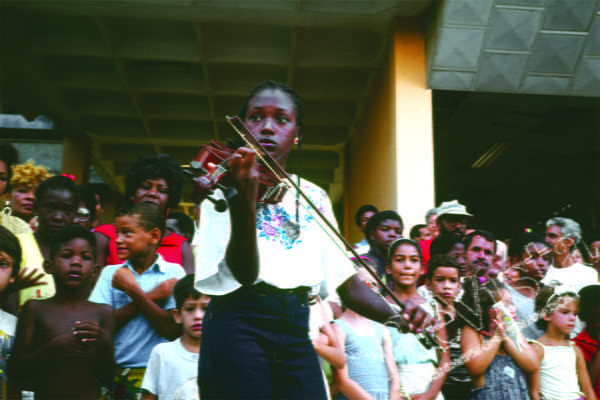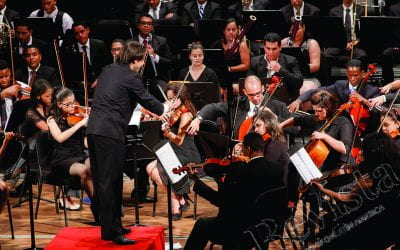First Take: Music and Nature
From Humpbacks to Harvard

A young woman plays the violin for a solidarity delegation of visiting North Americans in Cuba, 1993. Photo by Jonathan Moller.
Nature and music are intimately connected. Almost as long as I have been a naturalist, these connections have been woven through my life. I have been playing drums since I was a boy. Though I played in a rock band in high school, I was trained in jazz and Latin music, genres I play to this day. As a teenager I wrestled with the decision to follow music or something else (not yet fully aware how biology could be a profession), and am happy that one can pursue these two interests at the same time and discover eventually how closely they are tied together.
As a scientist, I am now more fully aware of the links. I notice the similarities between jazz—a famously improvisational form featuring trades of motifs between players, as if in conversation—and that of birds and other species that trade vocalizations to convey their motivations to each other. Music permeates nature, and nature permeates music.
I believe it is fair to say that for most people on earth, including myself, music is an integral part of everyday life. Our memories are often tied to certain songs or genres associated with the paths of our emotional lives, particularly in the teenage years. A song can carry us back in time and draw forgotten emotions from deep inside ourselves. Why does music have such a hold on us, able to change our mood and bring us together? What is music’s evolutionary origin, and can we learn about music by considering other species that use sounds in similar ways? These are old questions, but they have received new insights from fields as different as paleontology, neurobiology and evolutionary theory.
Music appeared early in human history, documented by the discovery of 40,000-year-old flutes made of bird bone or mammoth ivory, as well as remnants of ancient drums. Some scientists believe that the large nasal passages of the Neanderthals, who existed in Eurasia from nearly 500,000 to 35,000 years ago, indicate an ability to produce resonant chant. Experts in fields as different as neurobiology, archeology and evolutionary biology believe that music may have preceded language, and it is not hard to imagine that chanting and rhythmic thumping were instrumental in holding small tribal groups together. In fact, social cohesion most likely was a force for the adaptive basis of music in early humans.
The other force thought important for the development of music is sexual selection, meaning that music may have fostered the greater reproductive success of those who played and responded, just as the bright colors of a male bird’s plumage attract females who select their mating partner(s) based on their attractiveness. Certainly, the field of neurobiology has greatly increased our understanding of the depth and breadth of the “wiring” of our brains for music response and music production. While language abilities may be lost through a blow to the side of the head or a small lesion on the brain itself, musical production and responses are almost impossible to knock out. In fact, individuals who have lost their language abilities sometimes can learn to sing their thoughts.
Music reception and production both employ neurotransmitters that are key in brain function, as well as release hormones, such as serotonin and oxytocin, that are associated with the pleasure centers of the brain. These “feel good” hormones seem to reinforce the feelings of happiness and belonging that music often produces. Music shares features with humor and experiences of nature both by fulfilling expectations and by creating lively elements of surprise. Music, meditation, nature, artistic and religious experiences have similar effects on the brain, engendering the kinds of contemplative changes in brain waves that have concomitant positive effects on stress levels, and perhaps overall health. This is an area of active research.
Humans are remarkably adept at music. We can (famously) recognize a song from hearing very few notes, often two or three, and can pick out a song over the cacophony of a crowd. It is remarkable that, however closely we guard our feelings from strangers, or even from those familiar to us, we nevertheless express strong emotions toward music, especially played live. Recent investigations of the extensive cave systems in Lascaux, France, have revealed that the most acoustically-resonant chambers are the ones decorated with Paleolithic murals, leading to the conclusion that they were performance halls. I can say that this thought has transformed how I think about my own attendance of musical performances in resonant concert halls—we’ve been enjoying such experiences together for tens of thousands of years or more!
Humans are not the only acoustical performers on earth, of course. Birdsong has figured in our poetry for as long as there has been a written record, and the group we call songbirds that actually learn their songs from adults have been singing since the beginning of the Cenozoic Era, 65 million years ago. Of course, earlier birds were screeching and calling for 100 million years before, but they were not the first species to use sound to communicate their impassioned pleas for mates and territory. This would be the insects and frogs, whose rattles, scrapings and trills have resonated through swamp, forest and field for a quarter of a billion years. But, is it music? Some of us certainly love to be enveloped in these wild sounds—I sometimes have rainforest recordings playing in the background as I work—but music is so defined that it excludes many other species and sounds, however beautiful they may sound to us. According to many authorities, music contains repeated motifs that may be combined in various ways to produce a larger composition, and so includes atonal music such as some percussion, while also excluding pure tones that do not form such patterns, such as train whistles (though one could play a train whistle in a musical fashion!).
Defined this way, the songs of birds, lasting from a few seconds to several minutes in length, are truly songs, and new studies show that certain mice also sing. However, mice and birds are not the only songsters on earth, and they are far from being the largest. These would be the whales. For many centuries, fishermen and other maritime peoples were undoubtedly aware of the amazing vocalizations of whales, especially those of the humpback whales widespread in the Atlantic and Pacific oceans. However, it was not until a Harvard graduate named Roger Payne ’54 first recorded them from the back of his sailboat that these sounds were understood for what they were. Payne and his colleague Scott McVay analyzed their recording by marking the various motifs that appeared here and there across the thirty minutes or more of their duration. It became clear that these long vocal utterances were in fact composed songs that were repeated over and over again. Their landmark 1967 paper, followed by the 1970 commercial release of their recordings (Songs of the Humpback Whale), occasioned an enormous raising of awareness of these amazing creatures who sing below the waves, and highlighted their plight as whaling countries continued to drive whales towards extinction.
Jazz clarinetist Professor David Rothenberg ’84 takes whale music seriously, and has played music with whales (via underwater speakers) and birds, though it is very unclear as to whether they respond. While other animals may sing, no species apart from humans can follow a rhythm (though the dancing of a now defunct cockatoo named Snowball suggests such abilities in parrots). Drumming, therefore, comes closest to a musical signature that is uniquely human, surprisingly enough.
Today, I teach a Harvard Freshman Seminar entitled “Why we animals sing” that bridges acoustic biology and the evolution of music. I play in a weekly jazz ensemble and occasionally around the university and in my spouse’s home country, the Dominican Republic, which I find especially amenable to combining music and nature in one setting. For your Director of DRCLAS, this special issue of ReVista, dedicated to music, is therefore a very special pleasure, and I hope you find these authors’ contributions with a Latin perspective as rich as I do.
Winter 2016, Volume XV, Number 2
Brian Farrell is the Director of the David Rockefeller Center for Latin American Studies (DRCLAS) and a Professor of Biology who is Curator of Entomology in Harvard’s Museum of Comparative Zoology. He is also a jazz drummer and performs weekly at a Boston-area venue.
Related Articles
When Music Changes Lives
English + Español
n 2004, I got a surprising phone call from Santo Domingo on one cold winter night. I was then studying musical composition in Strasbourg, France, a great opportunity for a young Dominican…
The Politics of Gay Marriage in Latin America
Despite its recent successes, the gay rights movement in Latin America is generally ignored in discussions of contemporary Latin American politics. Even students of Latin American social…
The Yaquis and the Empire
Winner of the 2015 Latin American Studies Association Social Science Book Award and runner-up for the 2015 David J. Weber-Clements Prize of the Western History Association, The Yaquis…







